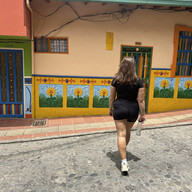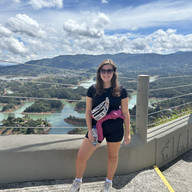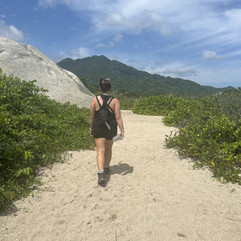Colombia: 2 and 3 week itineraries for Colombia
- thescattytravellers
- Jan 4
- 16 min read
Updated: Feb 17
Colombia is such a beautiful country. We honestly almost skipped it because I was so worried about safety having heard a few horror stories; while it's true that you do need to be careful where you go, overall I would say I felt very safe on the whole. There is a huge variety of things to do, from bustling cities to coffee farms, from jungles to beaches - Colombia has it all!
Summary of our itinerary:
We did Colombia relatively slowly, taking our time to really take in our surroundings. If you have less time, we would recommend removing days 10 & 14 from our itinerary below.
Day 1 - Bogota
Day 2 - Bogota
Day 3 - Travel to Salento
Day 4 - Salento - Cocora Valley
Day 5 - Salento - Coffee Farm AM, Tejo PM
Day 6 - Salento - Horse Riding AM
Day 7 - Travel to Medellin
Day 8 - Comuna 13 tour, Explore Medellin
Day 9 - Day trip to Guatape
Day 10 - Football game (optional)
Day 11 - Fly to Santa Marta
Day 12 - Tayrona National Park
Day 13 - Bus to Cartagena. Explore.
Day 14 - Exploring Cartagena and walking tour (optional)
Day 15 - Cartagena boat trip
Got more time in Colombia and fancy a hike? How about adding on the 4 day trek to the lost city. We didn’t do this but wish we had, as we met a couple of people that absolutely loved this! This tour goes from Santa Marta and has amazing reviews!
Remember that in the below itinerary, Tayrona National Park is closed in February for preservation, so if you are visiting in February, you'll not be able to visit and so we would recommend skipping Santa Marta as this is the main thing to do there.
Day 1 - Bogota
We were surprised how much we loved Bogota, and how modern and cosmopolitan it is! We recommend using Uber to get around here. You are at an altitude of 2640m which is just inside altitude sickness territory, however we did not experience any major effects.
We stayed in an area called Chapinero and recommend this area to stay in Bogota over La Candelaria. We stayed in a gorgeous serviced apartment with great views, located next to some fantastic cafes and restaurants. This area is extremely modern and safe, with lovely facilities and nice shopping centres neaby! We felt La Candelaria felt a little unsafe later in the afternoon, as well as a bit dirtier. We stayed in Urban Heights apartments and loved it!
On your first day in Bogota, I recommend settling in and getting some breakfast at Varietale. Afterwards, spend some time exploring Chapinero. We found it to feel very safe overall but didn’t walk around much after it had gone dark (mostly because we were exhausted with jet lag). Head over to Parque 93 for a drink, snack and some boutique shops. Afterwards, you can head to Centro Comercial Andino shopping centre if that's your jam. Chapinero has tonnes of amazing cafes, so this is a great day to adjust, explore and sample some of Colombia's finest coffee.

Day 2 - Bogota
In the morning, head over to Monserrate and hike up to the viewpoint. The hike itself took us 60 minutes but it is very much doable with a basic level of fitness. You can take a few breaks to look back at amazing views over Bogota! If you don't fancy hiking? You can grab the cable car up instead! The cable car leaves from the Teleferico station at the base of the hill (here on Google maps) and you can buy tickets online here.
In the afternoon, head over to the historic heart of the city, La Candelaria. Walk through the city's colourful colonial neighbourhood with cobblestone streets, murals and museums. We think the best way to see this part of the city is on a free walking tour; we used freetour.com and did this one - these tours are free but you are expected to tip! It was great to learn some history about Bogota and Colombia and is a great way to settle in to your trip.
Day 3 - Travel to Salento
To get to Salento, you need to first catch a bus to a city called Armenia, which can be booked in advance on busbud here. From Armenia, you can then catch a bus to Salento from the bus terminal (however this cannot be booked in advance). Once you get off your bus in Armenia bus terminal, there are lots of people to guide you the correct way - just ask an attendant. Make sure you have cash to pay for the bus ticket. The bus costs around COP6000 per person, and it runs until around 8pm each night.
Salento is a beautiful town, famous for its coffee farms. It felt really safe here and we could walk around after it had gone dark without any issues. This was our favourite location in Colombia, and one of our favourite in 7 months of travelling. Do not miss it!
When you arrive, check into your hotel and have a walk up to mirador Ecoparque the Mirador Alto De La Cruz to catch sunset. This is free and has beautiful views over Salento and the surrounding hills. We recommend staying at Hostel El Patio here - they have private rooms which are great.
Where to eat in Salento:
We found a couple of places that we absolutely loved in Salento.
La Tapería Salento for beautiful tapas dishes
La Martina had a gorgeous mixed meat rice dish which, paired with a Mango smoothie, was one of my favourite meals in Colombia!
Day 4 - Cocora Valley from Salento
Cocora Valley is famous for having the tallest palm trees in the world and is a truly beautiful place to do some hiking! To get there, you need to catch a Willy (basically a jeep) from the central plaza in Salento. You can get these early in the morning from around 7am, but we opted to snooze and caught a willy at 9am; we were able to leave straight away without queuing. You can get tickets from a small wooden hut in the central plaza. The cost for a return was COP10,000 per person and you will need to pay in cash. We did a longer loop hike which was approximately 15km and took about 4 hours with breaks in total. You can buy entry tickets for the park upon arrival, and they cost around COP7,000 per person, but take extra cash as some makeshift huts pop up and will demand some cash. Try to go left upon entering the park and do the loop clockwise rather than anti-clockwise as this is slightly better views to start with. There were a few restaurants and shacks to buy food and drink there however we definitely recommend taking enough water with you as it can get quite hot! Afterwards, just queue outside the park to catch a Willy back to town.
Day 5 - Coffee tour in Salento. Tejo PM.
In the morning, catch a Willy to your coffee tour! You buy tickets at the same hut mentioned above in Salento for the Willy. We did Finca el Ocaso and absolutely loved it. Click here to book the tour [affiliate link]. You will be assigned a group based on your desired language and their lovely tour guides will walk you through the full coffee-making process, from picking coffee beans to production, to marketing and exporting. You then get to try lots of different coffee and learn about taste testing!
Afterwards, head back to town. The Willy will come and pick you up after your tour from the farm. There are plenty of lovely cafes in town to relax in with out-of-this-world views. Our personal favourite was El Pato Hostel.

In the evening, we definitely recommend a game of Tejo! This is the national sport of Colombia. It basically involves throwing a rock at a target that has gunpowder in it (it's not as scary as you think). Depending on where you land on the target, you get a different number of points, however the ultimate aim is to hit the centre of the board. This will set off a gunpowder explosion! We went to Cancha De Tejo Los Amigos in the centre - it was super cheap (COP2000 per person to play) and a great vibe, but prepare for your clothes to smell like fireworks afterwards!
A Tejo explosion as demonstrated by our lovely friend:
Day 6 - Horse Ride, Salento.
Take a horse ride through the lovely countryside and coffee farms. We booked with Cabalgatas San Pablo and absolutely loved it. The ride itself was 2 hours and we went down through coffee farms, gorgeous scenery and walked through the most beautiful river. You can easily ride for longer. This was one of the highlights of our 7 month travelling trip.
The afternoon provides a great opportunity to go and do some shopping. Salento has lots of boutique shops with locally-made souvenirs, so if you want to take something home then this is a great place to buy yourself something. You can also spend some time relaxing with a beer, or walking the streets to take some pictures of Salento's many very colourful buildings.
We loved playing Tejo so much we played two days running! We hope you do the same. If not, you should also consider heading to Bar Danubio for a game of snooker with locals.
Day 7 - Travel to Medellin
Time to catch a bus to Medellin! Thankfully this is much more simple than getting to Salento. We booked this one and got this from the bus station in Salento. It’s only about a ten minute walk from the centre. The bus takes about 6 hours and gets into Medellin Terminal del Sur. When we got there, we grabbed an Uber to our accommodation. We recommend you do the same, be really careful flagging down taxis in Colombia as this can sometimes go horribly wrong!
We stayed in El Poblado and absolutely loved our stay at Poblado Guest House. Breakfast was included and was cooked in front of us each morning, and the staff were beyond helpful. El Poblado is a great place to stay and felt very safe, even after it had gone dark. It is full of restaurants, cafes and shops and actually has a slightly luxurious feel; it would easily fit in in London and we absolutely LOVED it here.
Once you check in, have a walk around el Poblado and grab some food. Here are the restaurants we absolutely LOVED in El Poblado:
Herbario: Delicious, authentic Colombian cuisine. A must try when in Medellin! We recommend trying the Bandeja Paisa here, which is the national dish of Colombia.
Chef Burger Provenza: If you're looking for a meaty pig-out, look no further than Chef Burger Provenza. Delicious burgers for all to enjoy.
El Zorro: Some fantastic pizza, served at a very reasonable price.
Sushi Gama or Bao Bei: If you fancy a break from heavier dishes, hit one of these two restaurants to see Colombia's take on Asian cuisines.
Medellin is famous for being home to the notorious Pablo Escobar. This means that you can do a Pablo Escobar tour, however some locals don't like it as it glorifies what he did and the impact he had on people's lives. For this reason, we chose not to do this tour.
Day 8 - Comuna 13 tour
Comuna 13 tour is a must. When Medellin was the most dangerous city in the world, Comuna 13 was the most dangerous place. We booked this tour [affiliated link] and absolutely loved it. We think that doing a tour is 100% necessary due to the safety aspect, as well as getting information from a well-informed local guide and the opportunity to ask questions. The tour meets in El Poblado and you get the train across to Comuna 13, changing at the cable car station for a view over the Comuna. The change in this place is remarkable, as it is now full of street dancers, street art, boutique shops and bars with amazing views. It is now much safer than it was, you'll be pleased to know!
A Comuna 13 tour in Medellín offers a journey through one of the city’s most transformative neighbourhoods. Once plagued by violence and poverty, Comuna 13 has undergone a remarkable social and cultural rebirth, becoming a symbol of resilience. Our guide was able to share personal stories about his father's memories of the area which was truly fascinating.
Day 9 - Day trip to Guatape from Medellin
A day trip to Guatapé from Medellín is one of the most memorable experiences in Colombia, combining breathtaking landscapes, vibrant culture and rich history. Just a 2-hour drive from Medellín, this charming little lakeside town makes for a perfect day trip. We absolutely loved our tour which you can book here [affiliate link].
If you are self-guiding, we will put some detail for you below:
You start your adventure early with a scenic drive through the lush Antioquian countryside. El Peñón de Guatapé is the first main stop, which is a 650-foot granite rock that towers over the surrounding landscape. Climbing its 740 steps is very tiring but worth it, and you’ll be rewarded with panoramic views of the stunning turquoise reservoir dotted with islands. The views are absolutely worth it! After the climb, head to the colorful town of Guatapé, known for its colourful buildings. You should take some time to stroll through the cobblestone streets and take plenty of photos. Don’t miss the Plaza de Zócalos, a picturesque square perfect for relaxing with a cup of Colombian coffee. You can take lunch by the lake - there are many restaurants overlooking the reservoir. You can try local dishes like bandeja paisa or fresh-caught fish. Finally, you can get a boat ride on the reservoir, where you will pass through Pablo Escobar's old house (now burnt out!)
Day 10 - Football Game at Atanasio Giradot
Football is like a religion in Medellin; this is a must do experience for any football fans! Although the quality of the football is not the best (shhh don't tell the locals!), the atmosphere is next level! The city hosts two prominent teams: Atletico Nacional and Independiente Medellin. Both teams share the Atanasio Giradot Stadium, with a capacity of 40,000. We recommend doing this via a guided tour - we did this one which was excellent. Tickets, transport, a few beers and also background info are all included. You can get a football shirt outside the stadium at one of the many stalls for £5!
Day 11 - Travel to Santa Marta
Catch a flight from Medellin to Santa Marta. Simón Bolívar International Airport (SMR) is the airport you'll need to fly into in Santa Marta. We stayed in Casa de Isabella which was absolutely amazing; super modern, comfortable, breakfast included and an excellent location.
There isn't much to see in Santa Marta itself, but we enjoyed having a stroll along the beach and to the port. Have a mooch around the town, shops and grab some food. Some of our favourite restaurants are listed below:
Lulo Cafe Bar: Food so nice, we visited twice! Lots of lunch and dinner options, including burgers, local dishes, sandwiches, soups and homemade desserts.
Agua de Rio Cafe Bistro: Delicious, fresh food served all day round. The pancakes for brunch are a treat!
Safety in Santa Marta: Our hotel reception warned us to be careful on the safety here; not walking down quiet roads at night and even getting a taxi to the bus in the morning as we went super early before the shops were open. Uber doesn't work here but definitely get your hotel to order you a taxi if you need one!
Day 12 - Tayrona National Park
Getting to Tayrona National Park: You can take either a boat or a bus to get to Tayrona, but we recommend just getting the bus as it runs more frequently and is more reliable. It takes about 1 hour to get to Tayrona National Park from Santa Marta via bus. The earlier you can go the better, as Tayrona National Park gets busier later on. Also we recommend avoiding the weekend if you can, so that there are less locals there and thus making the park quieter to enjoy!
There are two places where you can take the bus from Santa Marta to Tayrona:
At the central bus station – Outside the city
At the Mercado Publico (Market) | Calle 11 con Carrera 11 (city bus).
Buses run all day and you can return until around 6pm and a return trip costs COP15,000 per person. When you get there, the bus will drop you off at the ticket entrance. This is actually a c.30 min walk to where you start the hike through the national park. There are minibuses that you can pay COP5,000 for to cut out this bit of the walk.
Private transport: If you are willing to pay, private transport is of course much more convenient and comfortable!
What do I need to bring to Tayrona National Park?
1) Passport (photocopy is OK - our hotel were kind enough to scan and print for us)
2) Walking boots
3) Towel, swimming clothes, change of clothes if desired
4) Bug spray and sun cream
5) Plenty of water (you can buy food and snacks there, but better to be safe as it is very humid)
6) Cash: Part of the entrance ticket needs to be paid in cash, so you will also need cash for lunch, the bus, any ice creams or drinks that you may want.
Entrance fees are COP68,000 per person during high season.
When you get there: We decided to do the hike to Cabo San Juan, which we LOVED. The hike is about 2.5 hours (one way) through a variety of forestry, palm trees, wooden walkways, beaches and coastal viewpoints and is absolutely gorgeous! The path is very obvious, so no need to bring a map. When you reach the beach, there is a restaurant for lunch (we recommend the seafood rice!) and the sea is beautiful for a swim to cool down. You can walk back the way you came to get the bus back - just take plenty of water as it is extremely humid.
Day 13 - Travel to Cartagena
Catch a transfer to Cartagena in the morning. The easiest way to do this is via a transfer, which is pretty cheap. We booked this here. Thankfully, Uber does work in Cartagena, so it is pretty easy to get to your accommodation once you arrive at the transfer company headquarters!
Safety in Cartagena: We found the old town to be safe, but you have to be a little bit more careful outside of the old town, especially at night. I would recommend getting an Uber in the dark if you stay outside of the old town. Other than that, there are a LOT of street sellers that will stop you constantly (this was the only thing we did not like about Cartagena), so prepare to say "no gracias" 100 times a day!
Where to stay: Anywhere inside of the Old Town is ideal. We had friends that stayed at Moet Cartagena and loved it - it's a little more luxury, but looked fabulous. We stayed at Casa Cielo Hotel, which was pleasant enough and a good option for a cheap stay.
Once you have checked into your hotel, you should definitely grab a free walking tour! There is no better way to get to know a new area and find out the history, which Cartagena, as an ex-colonial town, is full of! We recommend this one. Whilst in Cartagena, keep an eye out for sloths in the trees, we saw a few in Parque Centenario. If you have some spare time, Cartagena is a great place to explore - you should take some time to walk inside the city walls and explore. Top tip: Cartagena had plenty of delicious ice cream shops, so definitely a place for some sweet treats. Locals LOVE mango with salt and chilli on them - don't knock it 'til you've tried it; you can buy these near the main gates into the city walls from a street vendor for a delicious snack.
Where to eat in Cartagena: We found many restaurants we loved here. A few of our favourites are:
Los Tacos del Gordo: Delicious tacos. Super affordable.
Alma: Serves delicious Colombian dishes which we loved. Bandeja Paisa a must try!
Dona Lola: For delicious seafood and perhaps a bit more of a special occassion.
Di Silvio Trattoria: Recommended to us by a local, it serves some amazing pizza and pasta dishes.
Day 14 - Exploring day in Cartagena
There is SO much to do in Cartagena, so much so that we think there's enough to do here just exploring for an entire day:
1. Explore the Walled City: Stroll through the cobblestone streets of the historic center, admiring colonial architecture, colourful buildings, and lively plazas. This area is a UNESCO World Heritage site and offers numerous cafes, boutiques, and museums.
2. Visit Castillo San Felipe de Barajas: This impressive fortress, perched on a hill, showcases the city’s military history and provides panoramic views of Cartagena and the Caribbean Sea.
3. Relax on the Beaches: Nearby beaches like Playa Blanca on Barú Island offer white sands and clear waters, ideal for sunbathing and swimming.
4. Experience Getsemaní Neighborhood: Once a neglected area, Getsemaní has transformed into a cultural hub, known for its street art, vibrant nightlife, and authentic local atmosphere. It’s a great place to experience Cartagena’s culture. If you like getting that perfect insta shot, this is a cool place to explore with your camera!
5. Enjoy Local Cuisine: Indulge in traditional dishes like ceviche, arepas, and fried fish. The fish here is caught nearby, brought into Cartagena harbour and sold at markets and to local vendors, so it is extremely fish. It was some of the nicest seafood we have had during our travels!
6. Attend Cultural Festivals: Depending on the time of your visit, you might get to experience events like the Cartagena International Music Festival in January or the International Film Festival in March. Plaza de La Trinidad has music and dancing which you can join in with most nights of the week - it was awesome!
7. Visit the Palace of the Inquisition: This museum offers insights into Cartagena’s colonial past - if you're a history geek, it's well worth a visit.
8. Walk Along the Old City Walls: Built to protect the city from invasions, these walls now provide scenic walkways with views of the sea and the city; the view of the fortress is stunning at night.
9. Experience Nightlife: Cartagena has a lively nightlife scene with numerous bars, clubs, and live music venues, particularly in the Getsemaní area. Salsa dancing is a popular activity for both locals and visitors - you can participate at Tertulia de Getsemani.
Day 15 - Boat Tour from Cartagena
Various boat tours offer excursions to nearby Rosario islands for snorkelling, swimming, and relaxation in a picturesque setting. The water is genuinely beautiful here, and we would highly recommend doing a day trip to relax on your final day. We did this one [affiliated link] and highly recommend it for pure relaxation and VIP treatment!
Day 16 - Exit via Cartagena airport
It's time to go home. Boo. Hiss. Sad times.
How long should I spend in Colombia?
We think you can do a great trip to Colombia in 10 days to 2 weeks - our 16 day itinerary (above) is perfect! If you enjoy a slower pace of travelling, 2.5 to 3 weeks should be plenty of time to immerse yourself in all that Colombia has to offer.
Is Colombia safe?
We were pleasantly surprised in that we felt very safe for most of our trip in Colombia. That said, the country does have something of a reputation for being a dangerous place and so precautions are necessary. Be polite to street vendors who hassle you in order to avoid confrontations. At night, do not walk alone or in quiet places away from touristy areas, as muggings can occur - just take an Uber, it is not worth the risk. Do your research about areas you are visiting too. Overall, we felt that Salento was extremely safe, with Santa Marta, Medellin and Bogota a little more on the sketchy side at night or in quieter places. Food hygiene is generally pretty good in Colombia, but do stick to busier places that look like they have a reasonable level of hygiene.
What is the best food to try in Colombia?
Bandeja Paisa: This is Colombia's national dish, which includes pork, ground meat, beans, avocado, egg, chorizo, rice and plantains. We loved this dish and it's a must have during your trip to Colombia.
Fruit: Colombia has an abundance of fresh fruits, some of which I have never heard of. Our particular favourite was "Lulo" - a sweet and slightly sour fruit, delicious in smoothies. The satsumas are also so sweet and delicious.
Mango and chilly: A delicious snack eaten by locals, fresh mango is covered in salt and chilli flakes. It's genuinely delicious and I would highly recommend giving it a try.
Coffee: OK it's not a food, but Colombian coffee is infamous. Make sure you try lots of different types and flavours during your trip to Colombia; good coffee can be found at most cafes in Colombia's cities.
Do I need a visa for Colombia?
British passport holders do not need a visa to visit Colombia for up to 90 days.
Do people speak English in Colombia?
Generally, no - people speak very little English in Colombia. Our tour guides were about the only people we encountered who could speak English well. It's time to get Duolingo and/or Google Translate out!






































































































Comments